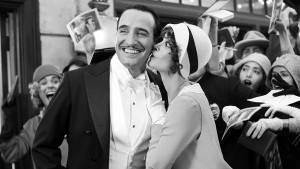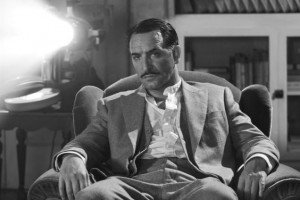 I’m going out on a limb here — but a sturdy one — to say it’s almost impossible not to love The Artist, the French homage to silent pictures that snapped up five well-deserved Oscars on Sunday: Best Picture, Best Director and Best Actor, as well as awards for costume design and original score. Having previously received many other honours, it’s now officially the most awarded French film in history. (See also the New York Times review by A.O. Scott.)
I’m going out on a limb here — but a sturdy one — to say it’s almost impossible not to love The Artist, the French homage to silent pictures that snapped up five well-deserved Oscars on Sunday: Best Picture, Best Director and Best Actor, as well as awards for costume design and original score. Having previously received many other honours, it’s now officially the most awarded French film in history. (See also the New York Times review by A.O. Scott.)
Written and directed by filmmaker Michel Hazanavicius, The Artist is the tale of star-crossed actors in the dying days of silent film. Jean Dujardin plays George Valentin, a cinema idol with an irresistible grin but a fading career and a rocky marriage. His sidekick, onscreen and off, is a clever Jack Russell terrier named Uggie. Bérénice Bejo plays the aptly named Peppy Miller, a young chorus girl and aspiring actress who kick-starts her career by giving George a casual kiss on the cheek that makes the pages of Variety.
An attraction develops between them, of course, but while Peppy’s career is on the rise, George’s threatens to collapse as silent films are pushed aside to make way for the “talkies.” And therein lies the story.
Here are some thoughts on writing that occurred to me as I watched and enjoyed The Artist. They apply equally to writing fiction or creative nonfiction.
1. Don’t be too timid to take risks with form.
Play. Experiment. Take chances in your writing. While there are certain conventions in story writing and it’s important to understand them, we’ve all read stories that turn convention on its ear to create something meaningful and memorable.
Who would have thought that some 83 years after the last silent film took an Oscar — and amid today’s blockbuster movies jammed with action and computer-generated special effects — a sweet, silent, black-and-white movie would capture our hearts?
Hazanavicius took a creative leap of faith and it paid off. As a writer, your leaps of faith could too.
2. Make your opening a grabber (but a relevant one).
Put time and effort into your opening lines. They’re the door you swing wide for visitors, and the impression they make will determine whether those visitors stay for the party. Opening lines also set the tone and style and sometimes the theme for the tale that follows.
In The Artist’s opening scene, we see George, as a hero in one of his silent movies, being tortured but refusing to speak. This sounds grim, but we quickly realize it’s a tongue-in-cheek glimpse of a movie within a movie, and a self-referential nod to the fact that we’re in an audience watching a film ourselves. It also foreshadows the conflict to come when George refuses to accept that “talk” will soon bury his beloved silent films. This opening works for this film on many levels.
Except in rare cases you’ll likely revise your opening lines many times before they feel just right — but they’re worth it.
3. Remember your two C’s: Character and Conflict.
Establish compelling characters and your reader will follow them anywhere. Then, introduce conflict (internal or external) — something your characters are struggling to get or achieve or overcome — and the resulting tension and attempts at resolution will drive your story.
In the film, George and Peppy are immediately appealing and sympathetic. We respond to his mature charm and assuredness, though we sense the ego that may be his downfall. We are attracted to her youth, her quick wit and vivacity. Within minutes, the writer has rendered these characters beautifully through simple but telling scenes.
Give your characters desires, and then thwart them, and you’ve got the sort of tension and momentum that drives any good piece of fiction or memoir. George wants what he can’t have: to keep making silent films despite evidence of their plummeting popularity. Peppy wants what she can’t have in addition to her career: George, who happens to be married, not to mention that he’s toppling head-first into an existential crisis.
Ultimately, because their individual successes in the film business depend on very different outcomes, they come into conflict with one another, and tension is sustained when they repeated try, and fail, to achieve what they each want.
As in all writing, where there’s conflict, there’s story.
4. Show, don’t tell.
You’ve heard this one often but it bears repeating. And here’s what’s fascinating about The Artist: because it’s a silent film, it is refreshingly free of telling. There’s no narration, no dialogue (aside from the occasional inter-title), no inner monologues, no way the writer/director can summarize events or deliver backstory in words. The Artist is pure showing.
In the film, we “see” everything we need to know and understand — and there’s an example here for writers of all forms and genres.
5. Recognize that characters can “speak” without speaking.
Every line of dialogue you include in your stories should have a purpose, whether it’s to show someone’s character, to illustrate a relationship between characters, or to move the plot forward. Faced with the limitations of silent film, The Artist uses inter-titles for dialogue but — this is key — only where absolutely necessary.
When we can’t hear speech, as in the film, what cues do we focus on to understand a character’s thoughts and emotions? Everything else: facial expressions, the smallest of gestures, body language, physical position and movement within the setting and in relation to other characters, even the style and state (tidy? dishevelled?) of hair and clothing. In the film, the characters seldom speak, but we always know what they are saying and feeling.
Dialogue, along with inner monologue, in writing is essential and effective. It’s in-the-moment, and economical, and active. But there are many other ways your characters can “speak” to the reader.
 6. Create scenes that linger in the mind.
6. Create scenes that linger in the mind.
Long after the details of a story are forgotten, strong individual scenes live on in the reader’s (and viewer’s) mind. They’re as important for a short story or a book as for a film.
What you’ll take away from The Artist, I guarantee, are a dozen or more of these gems — funny, poignant, dramatic, romantic, surprising — including the moment George and Peppy first, literally, bump into each other and their eyes meet; the scene in which George is intrigued by shapely women’s legs dancing beneath a screen; the scene in which Peppy finds herself alone in George’s dressing room and spies his empty suit …
Memorable scenes — high points of a story that are played out moment by moment, in real time — will grant your writing longer life.
7. Appeal to the senses – but not necessarily the anticipated ones.
As you write, remember the five senses — sight, hearing, smell, taste and touch. Think about how they work together, how they overlap, and how when one is diminished, others respond to compensate.
Something that fascinated me in watching The Artist was that absence of voices and everyday sounds made me observe in a new way, participating as a viewer differently than I would have in a film with sound. I was more keenly aware of visual details, characters’ expressions and their movements, settings, and recurring symbols. Because of the lack of colour, I noticed instead light and shadow, contrast, the appearance of texture, reflections, and movement.
I was also more conscious of what I was hearing: the beautiful score by Ludovic Bource. It was an integral part of the experience, complementing what unfolded onscreen, heightening emotion and sometimes foreshadowing events.
There’s something immensely satisfying about having a writer, in print or on the screen, challenge our senses — and therefore our imaginations — in a new way.
8. Allow dashes, not a dollops, of symbolism.
Symbolism — a person, place or thing that stands for something beyond itself within a story — is important to good storytelling. But it has to be handled delicately. While symbolism in The Artist sometimes felt a bit heavy-handed, this was probably meant to harken back to the style of older silent films (or even films by some of the masters, such as Hitchcock).
A few recurring symbols in The Artist are the “three wise monkeys” (see no evil, hear no evil, speak no evil); the beauty mark that George first draws above Peppy’s lip; the staircase on which they meet halfway to chat, he, significantly, heading down, she heading up; mirrors and other reflective surfaces in which George sees his previously glossy self-image eroding; and so on. Uggie the dog, part of George’s world onscreen and off, is a symbol of the blurring between life and art that the film explores. There are others but I’ll let you discover them yourself.
Allow symbols to develop naturally out of your writing — they shouldn’t be forced — and blend them in with a light hand.
9. Choose your minor characters for a reason (or, Dogs are people too).
Uggie isn’t just another pretty furry face. You’ll see.
 10. Tell simple tales with artistry.
10. Tell simple tales with artistry.
As critic Chris Knight said in his National Post review of The Artist, “… great stories don’t need bells and whistles.” The Artist is, in the end, a simple story. Boy meets girl, boy loses girl … and, well, you know the rest. At least you think you do.
The point is that in strong writing, the magic is often less in the tale itself than in the original way it’s presented. The Artist fills our senses (even without sound or colour), teases our imagination and emotions, and satisfies the story-lover in us.
Most important of all, it follows us home.
At its best, your writing should too.
Did you see The Artist? If so, what did you think of it? Did you take from it anything you can apply to your own writing? I’d love to read your comments.
Allyson, I have not seen “The Artist” and until I read your post, didn’t think I wanted to – but now? I can’t wait to see it, not just for the movie itself but to tap into the things I can bring home to my writing.
My thoughts exactly. But you expressed them far better than I could.
From Katrine Geneau:
I’m amazed at how comprehensive and complete this is, and how much you were able to take from the movie. I’m assuming you only saw it once. (Or did you?) It seems that you had just seen it when we had coffee and you posted it the next day. Wow! You are brilliant. Thank you.
From Susan Siddeley:
Thanks for the great piece. I took it to the Santiago Writers’ meeting.